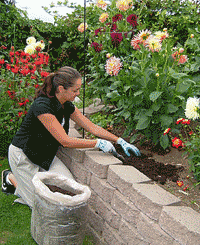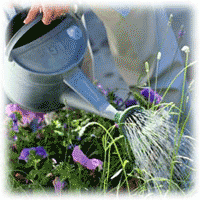WATER is as vital for plants as it is for other organisms.
 The pressure of water within a plant’s cells helps the leaves to remain firm. Water is also essential for most of the plant’s biochemical reactions. Moreover, water stores essential dissolved nutrients.
The pressure of water within a plant’s cells helps the leaves to remain firm. Water is also essential for most of the plant’s biochemical reactions. Moreover, water stores essential dissolved nutrients.
How often plants need water depends on how hot, dry, and windy the climate is; how well the plant tolerates dry conditions; and how deep the roots go into the soil.
Plants can be watered at any time of day. However, to avoid plant diseases that thrive in cool, moist conditions, and to reduce water loss through evaporation, gardeners water their plants in the early morning hours, when the air is cool and still, although the sun will soon dry the leaves.
The best method for watering plants is to apply the water directly to the soil, rather than over the tops of the plants. The water should be applied at a rate no faster than it can percolate into the soil, so that the excess water will not run off and be wasted. This technique reduces water loss through evaporation, and keeps leaves dry, thus discouraging diseases.
Tools of the trade
There are some tools which are effective in watering the soil efficiently. A soaker hose — a hose with tiny holes all along its surface — is one such tool; as are plastic tubes with tiny holes punched in them at intervals, which is very good for drip irrigation.
Plastic jugs with small holes punched in their bottoms are very effective in watering the soil when filled with water and set besides a plant. Watering large, densely planted areas, such as lawns, requires a sprinkler.
Evaporation of water from the soil can be minimized by covering the soil with a protective layer known as mulch. Mulch acts as a barrier that slows evaporation by reducing the amount of air and heat that reaches the soil surface.
Materials that can be used as mulch include leaves, bark chips, grass clippings, and cardboard.
Controlling garden pests
Three types of molesters can plague gardens: weeds, insects, and diseases. A weed is any plant that grows where the gardener does not want it to grow. Weeds are undesirable because they compete with garden plants for light, water, and nutrients.
Common methods of controlling weeds are to pull them up by hand, dig them out, or cut them off using a hoe or mower. One way to slow the growth of weeds is to cover the soil with a layer of mulch, which blocks out the light and air that weeds need to grow. Weeds also can be controlled by treating them with a weed killer, or herbicide. Like fertilizers, weed killers can be organic or synthetic.
One way to slow the growth of weeds is to cover the soil with a layer of mulch, which blocks out the light and air that weeds need to grow. Weeds also can be controlled by treating them with a weed killer, or herbicide. Like fertilizers, weed killers can be organic or synthetic.
Insects damage plants by chewing leaves or other plant parts, or by sucking the liquid from the plant; or, in some cases, by transmitting viruses to the plant. The amount of damage insects can inflict on a garden can be reduced by growing a variety of plants in that garden. Different plants attract different insects, including some insects that attack insect pests.
Another method of preventing insect damage is to cover young plants with a floating row cover, which is a very thin, white, gauzy blanket that keeps many insects away from the plants. Another preventative method is to grow plants bred for resistance to insect pests.
Some insects can be kept in check by introducing beneficial bacteria or insects to the garden. This method exploits the natural ecological relationships between garden pests and other organisms. Ladybugs, for instance, eat aphids, one of the more notorious garden insect pests, and certain types of bacteria kill insect larvae.
Another method of controlling insects in vegetable and flower gardens is to rotate crops, instead of growing the same type of plant in the same place every year. The life cycle of many insects depends on the presence of certain types of plants. By removing those plants for at least two years, the life cycle of certain insects can be interrupted, thus controlling those pests. Both organic and synthetic insect-killing materials, called insecticides, are also available to control insect pests.
Diseases caused by fungi, bacteria, or viruses can also damage plants. Once a plant has a disease, in most cases it cannot be saved. Although some fungal diseases can be controlled with a fungicide, the best approach to disease prevention is to provide plants with optimum soil, nutrients, light, and water, so they can fight off disease; and to grow plants that have been bred for disease-resistance, or have natural resistance.
(Courtesy of Erin Haynes of the Evergreen Nature Study Club www.evergreenstudy.org)
EDITOR’S NOTE: The Evergreen Nature Study Club is a non-profit organization geared to educate and re-educate persons on environmental literacy, coupled with nature tours. As the Club observes its fifteenth anniversary this year, readers are reminded that it offers nature-based goods and services, including technical advice.





.jpg)








